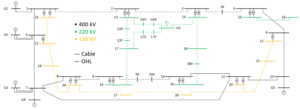
PhD project – Calculation methods for power systems facing large uncertainties
The electric power system is undergoing changes including large-scale introduction of renewable energy sources together with HVDC/FACTS, changes in the network such as increased amount of high voltage cables, industrial electrification, and changes in the load composition. These changes will impact the system in different ways and lead to challenges that must be addressed to facilitate planning, dimensioning, and operation of the system in a secure and economical way.
Uncertainties, e.g. in the operational conditions of the system, or in the modelling of components, can be addressed in several ways. A common approach is to perform Monte Carlo simulations, but depending on the scale of the problem (the model extent, the number of uncertainties and their characteristics, etc.), this may not be practical or even possible. At the other end of the spectrum are deterministic methods, which often use some kind of “worst-case” conditions. In case of significant uncertainties, such methods may give overly pessimistic results, resulting in the use of large design margins and high costs.
This work investigates the application of different methods for managing uncertainties related to the calculation of overvoltages and harmonic propagation. The methods are described, and their advantages and limitations are discussed and illustrated through case studies considering typical uncertainties.
The project was carried out by Independent Insulation Group in cooperation with Luleå University of Technology. Math Bollen (LTU) was the main supervisor with Jan Lundquist (I2G) as the co-supervisor.
PhD thesis
- O. Lennerhag, “Managing uncertainties through efficient calculation of transients and harmonic propagation in power systems“, PhD thesis, 2022
Appended journal papers
- O. Lennerhag, J. Lundquist, M. Bollen, “Efficient Calculation of Switching
Overvoltages Considering Corona Attenuation“, IEEE Transactions of Power Delivery (Early Access), 2023 - O. Lennerhag, J. Lundquist, M. Bollen, “Temporary Detuning of Cablified Transmission Grids for Mitigation of Resonant Overvoltages”, IEEE Transactions of Power Delivery, vol. 37, no. 2, 2022
- O. Lennerhag, M. Bollen, “Application of Unscented Transform for Efficient Calculation of Statistics for Electromagnetic Transients”, IEEE Transactions of Power Delivery, vol. 37, no. 5, 2022
- J. Lundquist, O. Lennerhag, “Minimum Voltage-Current Characteristic for Calculating Surge Arrester Energy Dissipation in Temporary Overvoltage Conditions”, IEEE Transactions of Power Delivery, vol. 37, no. 3, 2022
- O. Lennerhag, M. Bollen, “Impact of uncertainties on resonant overvoltages following transformer energization”, Elsevier – Electric Power Systems Research 187, 106503, 2020.
- O. Lennerhag, M. Bollen, “A stochastic aggregate harmonic load model”, IEEE Transactions on Power Delivery, vol. 35, no. 5, 2020
- O. Lennerhag, J. Lundquist, C. Engelbrecht, T. Karmokar, M. Bollen, ”An improved statistical method for calculating lightning overvoltages in HVDC overhead line/cable systems”, Energies, 2019
Appended conference papers
- O. Lennerhag, M. Bollen, “Managing Uncertainties in Wind Farm Harmonic Studies Using Unscented Transform”, ICHQP 2022.
- O. Lennerhag, M. Bollen, “Application of a stochastic aggregate harmonic load model to distribution networks”, CIRED 2021, Genéve, Switzerland.
- O. Lennerhag, M. Bollen, “A power system model for resonance studies”, CIRED, 2019, Madrid, Spain
List of additional publications
- O. Lennerhag, R. Rogersten, S. Råström, G. Sundström “Towards an ImpedanceBased Criterion for Efficient Analysis of Resonant Overvoltages in the Swedish Transmission System”, ICHQP, 2022
- D. Schwanz, M. H.J. Bollen, O. Lennerhag, A. Larsson, “Harmonic Transfers for Quantifying Propagation of Harmonics in Wind Power Plants”, Energies, 14(18), 5798, 2021
- O. Lennerhag, R. Rogersten, S. Råström, “A Parallel Resonance Investigation in Stockholm’s Future Cablified Transmission Grid: A Prospective Study on Transformer Energization”, IEEE PES Transmission and Distribution, 2020
- O. Lennerhag, A. Dernfalk, P. Nygren, “Harmonics and Supraharmonics in the Presence of Static Frequency Converters Feeding a 16 2/3 Hz Railway System”, International Conference on Harmonics and Quality of Power, 2020
- O. Lennerhag, M. Bollen, “Impact of uncertainties on resonant overvoltages”, IPST, 2019, Perpignan, France
- T. Karmokar, O. Lennerhag, “Simplified approach for investigating overvoltages in DC cables in a ±320 kV Symmetrical Monopolar HVDC System”, International Symposium on High Voltage Engineering (ISH), 2019, Budapest, Hungary
- O. Lennerhag, M. Bollen, “Power system impacts of decreasing resonance frequencies”, International Conference on Harmonics and Quality of Power (ICHQP), 2018, Ljubljana, Slovenia
Power system model for resonance studies
As part of the project, a power system model suitable for resonance studies has been developed. The model is partially based on an existing grid and the line types, tower configurations, cables, etc., are also based on what is typical in the existing power system. The example grid covers voltage levels from 400 kV to 400 V, with all relevant parameters included.
The benchmark model is included in PowerFactory as a built-in example case. It is used within CIGRE WG C4.46 – Evaluation of TOVs in Power Systems due to Low Order Harmonic Resonances.
An overview of the 400 , 220 and 130 kV voltage levels is given in the figure below.

The publicly available report “Power System Model for Resonance Studies” (ISBN 978-91-7790-213-3), describing the model and all parameters, is available on the following link:
Power System Model for Resonance Studies
A list of revisions can be found on the link below. Revisions are listed by date. The latest revision was performed 2020-03-04.
TM18-1001-01 Power System Model for Resonance Studies – list of revisions
